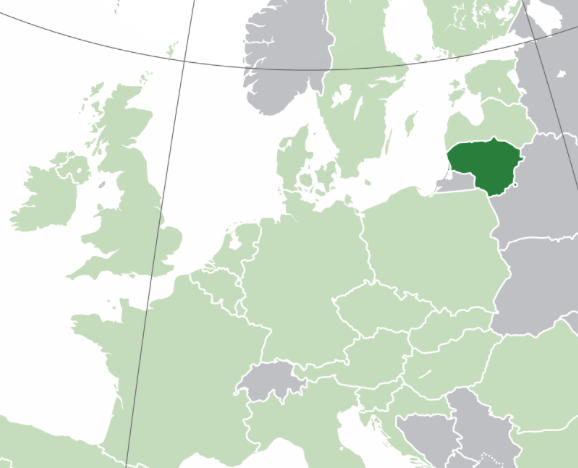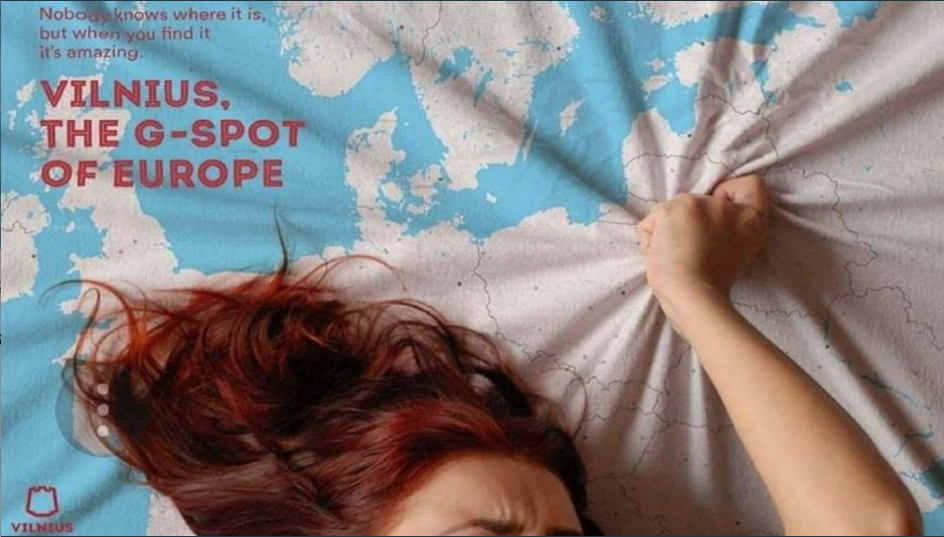
Lithuania is, admittedly, not well-known. Julia recently ran across the rather cheeky ad for its capital above, so they’re working on it. Lithuania’s a small country with a population (2.8 million) smaller than that of San Diego County. In its history, it has had major ups-and-downs, including dominance by Poland, Russia, and the Soviet Union. Now a member of the European Union and NATO, Lithuania is classified by the World Bank as a “high-income, advanced economy.” Wi-fi in Lithuania is public, free, and among the fastest in the world.
Lietuva is the southernmost of the Baltic states, south of Latvia and Estonia. It is at about 55 degrees north latitude, placing it north of the entire contiguous United States (lower 48). It is bordered by Latvia, Belarus, Poland, and Kaliningrad.
Baltic tribes were united in the Kingdom of Lithuania in 1253. In the 14th century, the Grand Duchy of Lithuania was the largest country in Europe, extending from the Baltic Sea to the Black Sea, consisting of current Lithuania, Belarus, and Ukraine, as well as parts of Poland and Russia. In 1569, Poland and Lithuania formed the Polish-Lithuanian Commonwealth, which lasted for more than two centuries. Neighboring countries then encroached and dismantled the Commonwealth, with the Russian Empire annexing most of Lithuania by 1795.
(My mother’s parents emigrated to the U.S. in the early 1900s. Their 1912 marriage license lists both of them as having been born in “Lithuania, Russia.”)
As World War I came to a close, Lithuania proclaimed its independence in 1918. In World War II, the Republic of Lithuania was first occupied by the Soviet Union, as part of its nonaggression pact with Nazi Germany, and then Nazi Germany. It was re-occupied by the Soviets as they drove the Nazis west and Lithuania became one of the Soviet “republics.” In March 1990, a year before the formal dissolution of the Soviet Union, Lithuania was the first Baltic state to declare its independence.
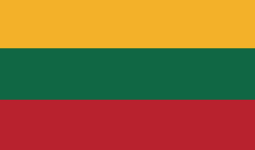
Not so fast, Soviets said. At the beginning of 1991, Moscow demanded that Lithuania relinquish its independence and restore its Soviet-drafted constitution. On January 13, 1991, pro-Soviet forces attempted to take power, seeking control of the Vilnius television station. Thousands of Lithuanians had gathered around the station. Using Soviet tanks, the pro-Soviet forces broke through the crowd, killing 14 and injuring more than 700, and took the station off the air. The situation in all the Baltic states was tense and unresolved until a failed coup in Moscow in August 1991 led Boris Yeltsin to accept their independence on September 7, 1991.
Lithuania was among the last European countries to be converted to Catholicism in the late 14th century. Soviet occupation after WWII closed churches and did not permit public exercise of religion. The most recent census showed more than three-quarters of the population identifying as Roman Catholic. Lithuania was an important center of Jewish scholarship and culture from the 18th century to WWII. Before the war, nearly 100,000 Jews lived in Vilnius, the capital, nearly half of the total population, and worshiped at more than 110 synagogues. Of the more than 220,000 Jews living in Lithuania in 1941, almost all were killed in the Holocaust. The current Jewish population is only a few thousand.
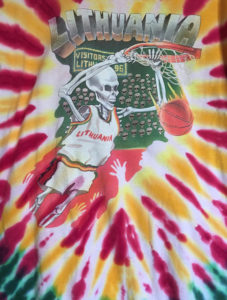 Perhaps the most frequent connection Americans might have with Lithuania is through basketball. It is Lithuania’s most popular sport and is considered the national sport. (I asked Vilius, our guide, where I might find a Lithuania soccer shirt as a gift. He looked at me askance and said Lithuania’s soccer teams were terrible. “You should get a basketball jersey!”) Lithuanian national teams are very successful and several Lithuanians have played in the NBA. (I still keep a memento of the Lithuanian Olympic team that won bronze in the 1992 Olympics.)
Perhaps the most frequent connection Americans might have with Lithuania is through basketball. It is Lithuania’s most popular sport and is considered the national sport. (I asked Vilius, our guide, where I might find a Lithuania soccer shirt as a gift. He looked at me askance and said Lithuania’s soccer teams were terrible. “You should get a basketball jersey!”) Lithuanian national teams are very successful and several Lithuanians have played in the NBA. (I still keep a memento of the Lithuanian Olympic team that won bronze in the 1992 Olympics.)
Eighty-four percent of those living in Lithuania, according to the 2011 census, are ethnic Lithuanians speaking Lithuania. About 6.6 percent are Polish and Russians 5.8 percent. Menus often were in Lithuanian, English, and Russian. Nearly all road and traffic signs were in Lithuanian and English. Lithuania is bordered on the northwest by Kaliningard, a Russian protectorate. We found Russian more common when we were near Kaliningrad.
Vilnius
Also sometimes referred to as Vilna, Vilnius is the capital of Lithuania and its largest city, with about 570,000 residents.
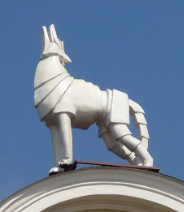 According to legend, Grand Duke Gediminas, after hunting in the area where Vilnius now is, had a dream of a huge iron wolf on a hilltop howling as loud as a hundred wolves. He asked a pagan priest the meaning of the dream and was told the wolf represented a castle and city that would be built on that site. The city that followed was at the confluence of two navigable rivers and surrounded by forests and wetlands that were difficult to penetrate, making it more defensible against Teutonic Knights.
According to legend, Grand Duke Gediminas, after hunting in the area where Vilnius now is, had a dream of a huge iron wolf on a hilltop howling as loud as a hundred wolves. He asked a pagan priest the meaning of the dream and was told the wolf represented a castle and city that would be built on that site. The city that followed was at the confluence of two navigable rivers and surrounded by forests and wetlands that were difficult to penetrate, making it more defensible against Teutonic Knights.
The Soviets built up several “minor-districts” on the outskirts of Vilnius, featuring large, grey, rectangular, high-rise apartment complexes. Despite that, only one-fifth of Vilnius’s 153 square miles is developed, the rest being parks, public gardens, lakes, etc., making it one of the “greener” European capitals.
Except for trips to and from the airport, Julia and I spent all our time in Vilnius in Old Town and I will post soon about our Day 2 tour.
Lithuania, part II: Old Town tour

